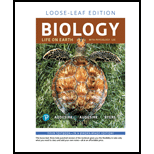
Concept explainers
Introduction:
Adaptive immunity is also called the acquired immune system. It is a selective immunity in which B or T lymphocytes are involved. The two subdivisions of an adaptive immunity are cell-mediated immunity and humoral immunity.
Answer to Problem 1MC
Correct answer:
The plasma cells of B cells synthesize antibodies that provide immunity against the infection. Each antigen has its specific antibodies and each antibody binds to a specific antigen. Therefore, option (b) is correct.
Option (b) is given as “produces antibodies with sites that can bind one or a few antigens”.
Explanation of Solution
Justify reason for the correct statement:
In humoral immunity, antibodies are involved. The B cell antibody recognizes the pathogen that travels in the bloodstream and lymph resulting in their destruction. During the first exposure of antigen, the lymphocytes (B lymphocytes or T lymphocytes) undergo division which results in the formation of plasma cell and memory cells.
The antibodies are secreted by B cells into the bloodstream which is presented on the surface of B cells to which antigen binds. The end of each arm of a heavy and light chain of an antibody consists of variable region which provides a site for antigen binding that binds to a specific antigen.
Hence, option (b) is correct.
Justify reasons for the incorrect statements:
Option (a) is given as “produces antibodies with sites that can bind many different antigens”.
B cell produces antibodies but each antibody is responsible for the binding of specific antigens. It cannot bind to different kinds of antigens as each antigen has its specific antibodies. Hence, it is a wrong answer.
Option (c) is given as “is capable of responding to many unrelated pathogens”.
Each antibody is specific to a particular antigen. It cannot respond to different pathogens as each antibody is antigen specific. Hence, it is a wrong answer.
Option (d) is given as “kills body cells infected with viruses”
Virus-infected cells are not killed by antibodies. Both natural killer cells and cytotoxic T cells recognize infected and cancerous cells by their different surface protein patterns. They recognize these cells as foreign or non-self cells of the body and kill them. Hence, it is a wrong answer.
Hence, options (a), (c), and (d) are incorrect.
B cells produce antibodies into the bloodstream. The amino acid sequence of variable regions of antibody is different in all antibody molecules. Due to this, each antigen has its specific antibodies.
Want to see more full solutions like this?
Chapter 37 Solutions
Pearson eText Biology: Life on Earth with Physiology -- Instant Access (Pearson+)
- ✓ Details Draw a protein that is embedded in a membrane (a transmembrane protein), label the lipid bilayer and the protein. Identify the areas of the lipid bilayer that are hydrophobic and hydrophilic. Draw a membrane with two transporters: a proton pump transporter that uses ATP to generate a proton gradient, and a second transporter that moves glucose by secondary active transport (cartoon-like is ok). It will be important to show protons moving in the correct direction, and that the transporter that is powered by secondary active transport is logically related to the proton pump.arrow_forwarddrawing chemical structure of ATP. please draw in and label whats asked. Thank you.arrow_forwardOutline the negative feedback loop that allows us to maintain a healthy water concentration in our blood. You may use diagram if you wisharrow_forward
- Give examples of fat soluble and non-fat soluble hormonesarrow_forwardJust click view full document and register so you can see the whole document. how do i access this. following from the previous question; https://www.bartleby.com/questions-and-answers/hi-hi-with-this-unit-assessment-psy4406-tp4-report-assessment-material-case-stydu-ms-alecia-moore.-o/5e09906a-5101-4297-a8f7-49449b0bb5a7. on Google this image comes up and i have signed/ payed for the service and unable to access the full document. are you able to copy and past to this response. please see the screenshot from google page. unfortunality its not allowing me attch the image can you please show me the mathmetic calculation/ workout for the reult sectionarrow_forwardIn tabular form, differentiate between reversible and irreversible cell injury.arrow_forward
- 1.)What cross will result in half homozygous dominant offspring and half heterozygous offspring? 2.) What cross will result in all heterozygous offspring?arrow_forward1.Steroids like testosterone and estrogen are nonpolar and large (~18 carbons). Steroids diffuse through membranes without transporters. Compare and contrast the remaining substances and circle the three substances that can diffuse through a membrane the fastest, without a transporter. Put a square around the other substance that can also diffuse through a membrane (1000x slower but also without a transporter). Molecule Steroid H+ CO₂ Glucose (C6H12O6) H₂O Na+ N₂ Size (Small/Big) Big Nonpolar/Polar/ Nonpolar lonizedarrow_forwardwhat are the answer from the bookarrow_forward
 Medical Terminology for Health Professions, Spira...Health & NutritionISBN:9781305634350Author:Ann Ehrlich, Carol L. Schroeder, Laura Ehrlich, Katrina A. SchroederPublisher:Cengage Learning
Medical Terminology for Health Professions, Spira...Health & NutritionISBN:9781305634350Author:Ann Ehrlich, Carol L. Schroeder, Laura Ehrlich, Katrina A. SchroederPublisher:Cengage Learning
 Concepts of BiologyBiologyISBN:9781938168116Author:Samantha Fowler, Rebecca Roush, James WisePublisher:OpenStax College
Concepts of BiologyBiologyISBN:9781938168116Author:Samantha Fowler, Rebecca Roush, James WisePublisher:OpenStax College Biology: The Dynamic Science (MindTap Course List)BiologyISBN:9781305389892Author:Peter J. Russell, Paul E. Hertz, Beverly McMillanPublisher:Cengage Learning
Biology: The Dynamic Science (MindTap Course List)BiologyISBN:9781305389892Author:Peter J. Russell, Paul E. Hertz, Beverly McMillanPublisher:Cengage Learning





